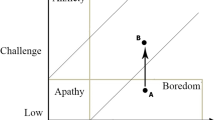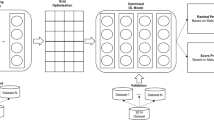Abstract
The National Basketball Association’s (NBA) tournaments are watched by people all over the world via the Internet of Things (IoT). Players who score more points are regarded as star players and are part of the focus of competition for each team. The purpose of this research is to predict the score of NBA league players based on player data using deep learning methods. Various algorithms were compared, the best model for score predictions was obtained, and a comparative analysis of the team was provided to the players. The prediction effect and average MAPE index of limit gradient boosting (XGB) are better than that of other methods. It can be seen that the XGB method has a better fit to the regression problem and high interpretability. Thus, it has the ability to accurately predict and evaluate NBA score predictions. The results can support the team's decision-making in player management.







Similar content being viewed by others
Explore related subjects
Discover the latest articles and news from researchers in related subjects, suggested using machine learning.References
Agrawal S, Singh S, Sharma J (2018) Predicting results of indian premier league T-20 matches using machine learning. In: 2018 8th International Conference on Communication Systems and Network Technologies (CSNT)
Baboota R, Kaur H (2019) Predictive analysis and modelling football results using machine learning approach for English Premier League. Int J Forecast 35(2):741–755
Chakraborty D, Elzarka H (2019) Early detection of faults in HVAC systems using an XGBoost model with a dynamic threshold. Energy Build 185:326–344
Chao L, Wen Z, Ji-ming L (2019) Study of star/galaxy classification based on the XGBoost algorithm. Chin Astron Astrophy 43(4):539–548
Chen T, Guestrin C (2016) Xgboost: a scalable tree boosting system. In: Proceedings of the 22nd Acm Sigkdd International Conference on Knowledge Discovery and Data Mining
Cooper W, Ruiz L, Sirvent I (2009) Selecting non-zero weights to evaluate effectiveness of basketball players with DEA. Eur J Oper Res 195(2):563–574
Danisik N, Lacko P, Farkas M (2018) Football match prediction using players attributes. In: 2018 World Symposium on Digital Intelligence for Systems and Machines (DISA).
Delen D, Cogdell D, Kasap N (2012) A comparative analysis of data mining methods in predicting NCAA bowl outcomes. Int J Forecast 28(2):543–552
Parsa A, Movahedi A, Taghipour H, Derrible S, Mohammadian A (2020) Toward safer highways, application of XGBoost and SHAP for real-time accident detection and feature analysis. Accid Anal Prev 136:105405
Chen CM, Chen L, Gan W, Qiu L, Ding W (2021) Discovering high utility-occupancy patterns from uncertain data. Inf Sci 546:1208–1229
Devan P, Khare N (2020) An efficient XGBoost–DNN-based classification model for network intrusion detection system. Neural Comput Appl, 1–16.
Glickman M, Sonas J (2015) Introduction to the NCAA men’s basketball prediction methods issue. J Quant Anal Sports 11(1):1–3
Gu W, Foster K, Shang J, Wei L (2019) A game-predicting expert system using big data and machine learning. Expert Syst Appl 130:293–305
Guo J, Yang L, Bie R, Yu J, Gao Y, Shen Y, Kos A (2019) An XGBoost-based physical fitness evaluation model using advanced feature selection and Bayesian hyper-parameter optimization for wearable running monitoring. Comput Netw 151:166–180
Rajawat P, Gupta D, Rathore S, Singh A (2018) Predictive analysis of medical data using a hybrid machine learning technique. In: 2018 First International Conference on Secure Cyber Computing and Communication (ICSCCC)
Ruiz F, Perez-Cruz F (2015) A generative model for predicting outcomes incollege basketball. J Quant Anal Sports 11(1):39–52
Štrumbelj E, Vračar P (2012) Simulating a basketball match with a homogeneous Markov model and forecasting the outcome. Int J Forecast 28(2):532–542
Tan L, Jin C, Cheng Z, Lv X, Song L (2019) Music style classification with compared methods in XGB and BPNN. arXiv preprint arXiv:1912.01203.
Lin B, Huang Y, Zhang J, Hu J, Chen X, Li J (2020) Cost-driven offloading for DNN-based applications over cloud, edge and end devices. IEEE Trans Industr Inf 16(8):5456–5466
Liu X, Huang G, Zhao Q, Mei H, Blake M (2014) iMashup: a mashup-based framework for service composition. Sci China Inf Sci 54(1):1–20
Visalakshi S, Radha V (2014) A literature review of feature selection techniques and applications: review of feature selection in data mining. In: 2014 IEEE International Conference on Computational Intelligence and Computing Research.
Zambom-Ferraresi F, Rios V, Lera-López F (2018) Determinants of sport performance in European football: What can we learn from the data? Decis Support Syst 114:18–28
Fu L, Li Z, Ye Q, et al (2020) Learning robust discriminant subspace based on joint L2,p- and L2, s-norm distance metrics. IEEE Trans Neural Networks Learn Syst. (Early access)
Ye Q, Li Z, Fu L et al (2019) Nonpeaked discriminant analysis. IEEE Trans Neural Networks Learn Syst 30(12):3818–3832
Nemeth M, Borkin D, Michalconok G (2019) The comparison of machine- learning methods XGBoost and LightGBM to predict energy development. In: Proceedings of the Computational Methods in Systems and Software
Oughali M, Bahloul M, El Rahman S (2019) Analysis of NBA players and shot prediction using random forest and XGBoost models. In: 2019 International Conference on Computer and Information Sciences (ICCIS)
Hore S, Bhattacharya T (2018) A machine learning based approach towards building a sustainability model for NBA players. In: Paper presented at the 2018 Second International Conference on Inventive Communication and Computational Technologies
Hsu P, Galsanbadam S, Yang J, Yang C (2018) Evaluating machine learning varieties for NBA players' winning contribution. In: Paper presented at the 2018 International Conference on System Science and Engineering (ICSSE)
Qiu W (2019) Credit risk prediction in an imbalanced social lending environment based on XGBoost. In: 2019 5th International Conference on Big Data and Information Analytics (BigDIA)
Qu Y, Lin Z, Li H, Zhang X (2019) Feature recognition of urban road traffic accidents based on GA-XGBoost in the context of big data. IEEE Access 7:170106–170115
Karthigha M, Akshaya VS (2022) A XGBOOST based algorithm for early prediction of human sepsis. In: 2022 4th International Conference on Smart Systems and Inventive Technology (ICSSIT)
Mekruksavanich S, Jantawong P, Jitpattanakul A (2022) LSTM-XGB: A new deep learning model for human activity recognition based on LSTM and XGBoost. In: 2022 Joint International Conference on Digital Arts, Media and Technology with ECTI Northern Section Conference on Electrical, Electronics, Computer and Telecommunications Engineering (ECTI DAMT & NCON)
Senbel S, SharmaS, Raval M, Taber C, Nolan J, Artan N, Ezzeddine D, Kaya T (2022) Impact of sleep and training on game performance and injury in division-1 women’s Basketball Amidst the Pandemic. IEEE Access
Hubáček O, Šourek G, Železný F (2019) Exploiting sports-betting market using machine learning. Int J Forecast 35(2):783–796
Ivanković Z, Racković M, Markoski B, Radosav D, Ivković M (2010) Analysis of basketball games using neural networks. In: Paper presented at the 2010 11th International Symposium on Computational Intelligence and Informatics (CINTI)
Joseph A, Fenton N, Neil M (2006) Predicting football results using Bayesian nets and other machine learning techniques. Knowl-Based Syst 19(7):544–553
Lee B, Worthington A (2013) A note on the ‘Linsanity’of measuring the relative efficiency of National Basketball Association guards. Appl Econ 45(29):4193–4202
Chen X, Lin J, Ma Y, Lin B, Wang H, Huang G (2019) Self-adaptive resource allocation for cloud-based software services based on progressive QoS prediction model. Sci China Inf Sci 62(11):219101
Chen X, Wang H, Ma Y, Zheng X, Guo L (2020) Self-adaptive resource allocation for cloud-based software services based on iterative QoS prediction model. Futur Gener Comput Syst 105:287–296
Tegicho B, Chestnut M, Webb D, Graves C (2021) Basketball shot analysis based on goal assembly disturbance. In: 2021 IEEE 12th Annual Ubiquitous Computing, Electronics & Mobile Communication Conference (UEMCON).
Ye O, Huang P, Zhang Z, Zheng Y, et al (2021) Multiview learning with robust double-sided twin Svm. IEEE Trans Cybernet. (Early access)
Abdulghani A, UCAN O, Ali Alheeti K (2021) Credit card fraud detection using XGBoost algorithm. In: 2021 14th International Conference on Developments in eSystems Engineering (DeSE)
Li S, Zhang X (2019) Research on orthopedic auxiliary classification and prediction model based on XGBoost algorithm. Neural Comput Appl, 1–9
Lim S, Chi S (2019) Xgboost application on bridge management systems for proactive damage estimation. Adv Eng Inform 41:100922
Huang G, Liu X, Ma Y, Lu X, Zhang Y, Xiong Y (2019) Programming situational mobile web applications with cloud-mobile convergence: an internetware-oriented approach. IEEE Trans Serv Comput 12(1):6–19
Huang G, Ma Y, Liu X, Luo Y, Lu X, Blake M (2015) Model-based automated navigation and composition of complex service mashups. IEEE Trans Serv Comput 8(3):494–506
Huang G, Xu M, Lin X, Liu Y, Ma Y, Pushp S, Liu X (2017) ShuffleDog: characterizing and adapting user-perceived latency of android apps. IEEE Trans Mob Comput 16(10):2913–2926
Mo H, Sun H, Liu J, Wei S (2019) Developing window behavior models for residential buildings using XGBoost algorithm. Energy Build 205:109564
Chen CM, Huang Y, Wang KH, Kumari S, Wu M (2020) A secure authenticated and key exchange scheme for fog computing. Enterprise Inf Syst 1–16
Chen X, Li A, Zeng X, Guo W (2015) Huang G (2015) Runtime model based approach to IoT application development. Front Comp Sci 9(4):540–553
Author information
Authors and Affiliations
Corresponding author
Additional information
Publisher's Note
Springer Nature remains neutral with regard to jurisdictional claims in published maps and institutional affiliations.
Rights and permissions
About this article
Cite this article
Su, F., Chen, M. Basketball players' score prediction using artificial intelligence technology via the Internet of Things. J Supercomput 78, 19138–19166 (2022). https://doi.org/10.1007/s11227-022-04573-6
Accepted:
Published:
Issue Date:
DOI: https://doi.org/10.1007/s11227-022-04573-6




